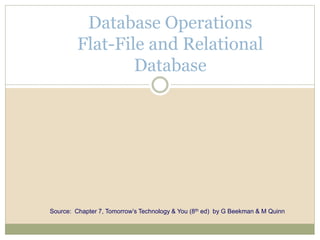
Relational database revised
- 1. Database Operations Flat-File and Relational Database Source: Chapter 7, Tomorrow’s Technology & You (8th ed) by G Beekman & M Quinn
- 2. Objectives So the students will be able to – Identify and discuss database operations Understand and explain the various special purpose databases Explain the difference between a flat-file and relational database Explain the concept of one-to-one and one- to-many relationships
- 3. Database Operations Imports data from other sources - from word processors, spreadsheets, or other databases Browsing records Database queries Query – an information request; can be a search for a specific record or all records that match a set of criteria
- 4. Database Operations Sorting Data – allows you to arrange record in alphabetic or numeric order based on values in one or more fields Print reports, labels, and form letters Display reports on screen or on printouts
- 5. Database Operations Complex queries – can be done using SQL (Structured Query Language) SQL , a special query language featured in most database program Used to filter the records of a database, capturing only those that meet the specific criteria Use common English language and common logical operator OR and AND.
- 6. Database Operations Use handout on – The Language of Database Queries Example of SQL statements: Select Vehicle_ID, Vehicle_Type FROM Rental_Vehicles WHERE Transport_Mode = ‘Land’ AND Rental_Price < 20.00
- 7. Special-Purpose Database Programs (SPDPs) Preprogrammed for specific data storage & retrieval purposes Users do not need to define file structures or design forms because these were taken care of by the software
- 8. Example of SPDPs 1. Directories – electronic phone directory that pack millions of names & phone numbers onto a single CD-ROM or Web site Electronic street atlas – uses information to provide location feedback for travelers & mobile workers from GPS feeds
- 9. Example of SPDPs 2. Geographic Information Systems (GIS) – simple mapping and tracking programs that combines tables of data from various sources Displays geographic and demographic data on maps Enable users to see data relationships that might be invisible in table form
- 10. Example of SPDPs 3.Personal Information Managers – can automate address / phone books, appointment calendars, to-do list, miscellaneous notes
- 11. Types of database programs 1. File managers – a program that enables users to work with one file at a time. Example: FileMaker Pro 2. Database Management System (DBMS) - a program that manipulate data in a large collection of files (database), cross- referencing between file as necessary Example: MS Access, Oracle
- 12. Type of Database structures Flat-file database – a database in which all records are stored in one large table. For example, in a flat-file customer order, a customer’s address, phone number, & other important information will be entered over and over again every time a customer placed an order. Characteristics of flat-file databases: It requires redundant data, which resulted into files of large sizes. It is difficult to maintain because it requires a large pool of human resources that equates to more salaries, office space and equipment.
- 14. Type of Database structures Relational Database – a type of database which consists of more than one file or table that are linked to each other by a common data and in which changes in one file are reflected automatically in other related files. The Relational Database Theory - solved the problem of redundant data (in a flat-file format). Dr. E.F. Codd – introduced the relational database theory in his published paper entitled “A Relational Model of Data for Large Shared Data Banks” in 1970. He introduced a set of rules that eliminate the need to store redundant data and formed the origin of relational database theory.
- 16. Advantages of Relational databases 1. Eliminate redundant data reduces the number of times a data item is entered therefore, minimizing data entry error. Each data item is stored only once, so if an error is made, only one entry will be corrected.
- 17. Advantages of Relational databases 2. Reduce data inconsistencies Data consistency – means rules or procedures followed in the entry and processing are one and the same for all users 3. Protect data integrity Data integrity – concerned with the correctness of data; data free from errors